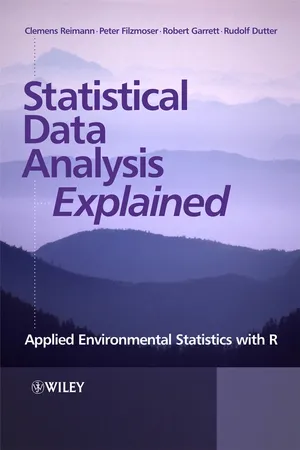
Statistical Data Analysis Explained
Applied Environmental Statistics with R
- English
- ePUB (mobile friendly)
- Available on iOS & Android
Statistical Data Analysis Explained
Applied Environmental Statistics with R
About this book
Few books on statistical data analysis in the natural sciences are written at a level that a non-statistician will easily understand. This is a book written in colloquial language, avoiding mathematical formulae as much as possible, trying to explain statistical methods using examples and graphics instead. To use the book efficiently, readers should have some computer experience. The book starts with the simplest of statistical concepts and carries readers forward to a deeper and more extensive understanding of the use of statistics in environmental sciences. The book concerns the application of statistical and other computer methods to the management, analysis and display of spatial data. These data are characterised by including locations (geographic coordinates), which leads to the necessity of using maps to display the data and the results of the statistical methods. Although the book uses examples from applied geochemistry, and a large geochemical survey in particular, the principles and ideas equally well apply to other natural sciences, e.g., environmental sciences, pedology, hydrology, geography, forestry, ecology, and health sciences/epidemiology.
The book is unique because it supplies direct access to software solutions (based on R, the Open Source version of the S-language for statistics) for applied environmental statistics. For all graphics and tables presented in the book, the R-scripts are provided in the form of executable R-scripts. In addition, a graphical user interface for R, called DAS+R, was developed for convenient, fast and interactive data analysis.
Statistical Data Analysis Explained: Applied Environmental Statistics with R provides, on an accompanying website, the software to undertake all the procedures discussed, and the data employed for their description in the book.
Frequently asked questions
- Essential is ideal for learners and professionals who enjoy exploring a wide range of subjects. Access the Essential Library with 800,000+ trusted titles and best-sellers across business, personal growth, and the humanities. Includes unlimited reading time and Standard Read Aloud voice.
- Complete: Perfect for advanced learners and researchers needing full, unrestricted access. Unlock 1.4M+ books across hundreds of subjects, including academic and specialized titles. The Complete Plan also includes advanced features like Premium Read Aloud and Research Assistant.
Please note we cannot support devices running on iOS 13 and Android 7 or earlier. Learn more about using the app.
Information
Table of contents
- Cover
- Title
- Copyright
- Preface
- Acknowledgements
- About the authors
- 1: Introduction
- 2: Preparing the Data for Use in R and DAS+R
- 3: Graphics to Display the Data Distribution
- 4: Statistical Distribution Measures
- 5: Mapping Spatial Data
- 6: Further Graphics for Exploratory Data Analysis
- 7: Defining Background and Threshold, Identification of Data Outliers and Element Sources
- 8: Comparing Data in Tables and Graphics
- 9: Comparing Data Using Statistical Tests
- 10: Improving Data Behaviour for Statistical Analysis: Ranking and Transformations
- 11: Correlation
- 12: Multivariate Graphics
- 13: Multivariate Outlier Detection
- 14: Principal Component Analysis (PCA) and Factor Analysis (FA)
- 15: Cluster Analysis
- 16: Regression Analysis (RA)
- 17: Discriminant Analysis (DA) and Other Knowledge-Based Classification Methods
- 18: Quality Control (QC)
- 19: Introduction to R and Structure of the DAS+R Graphical User Interface
- References
- Plates
- Index